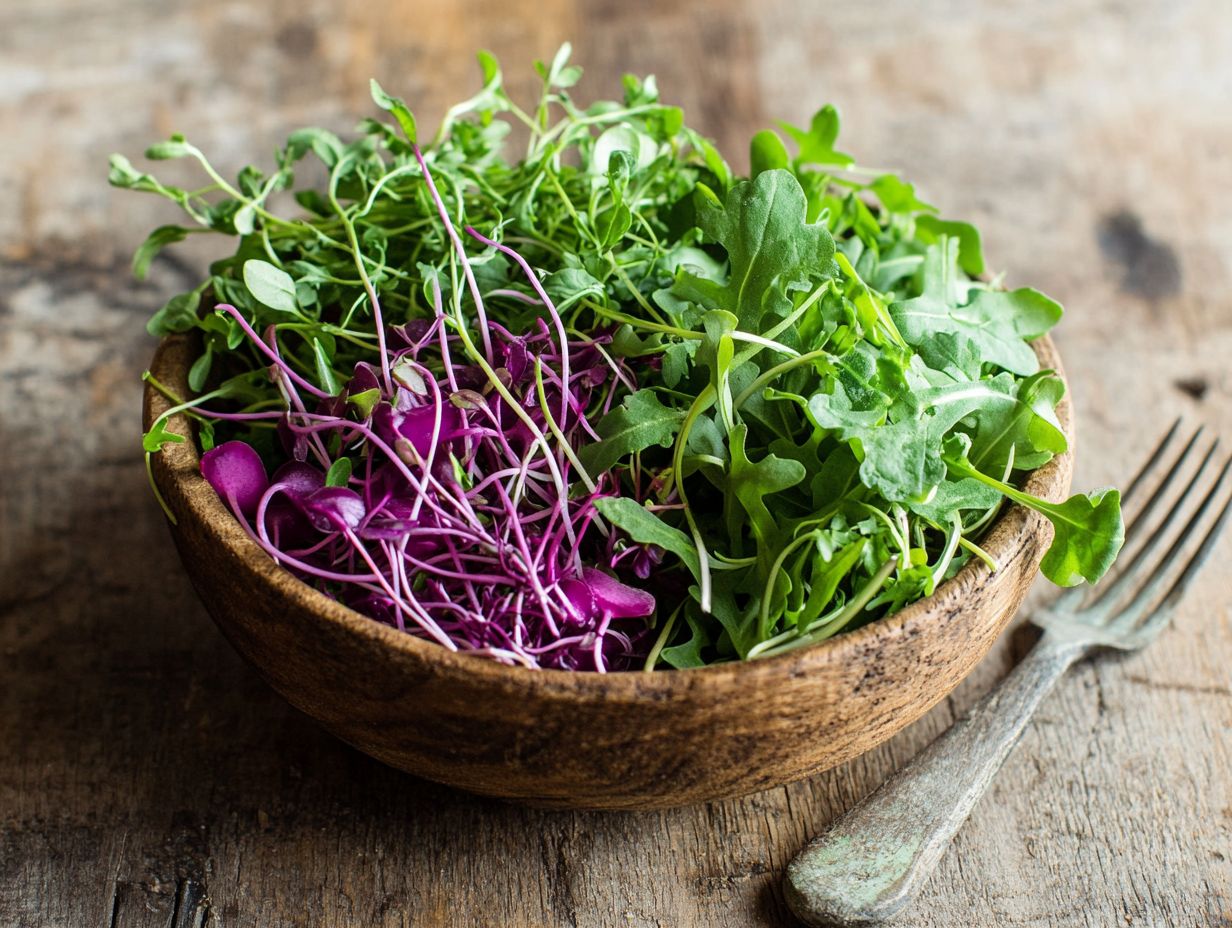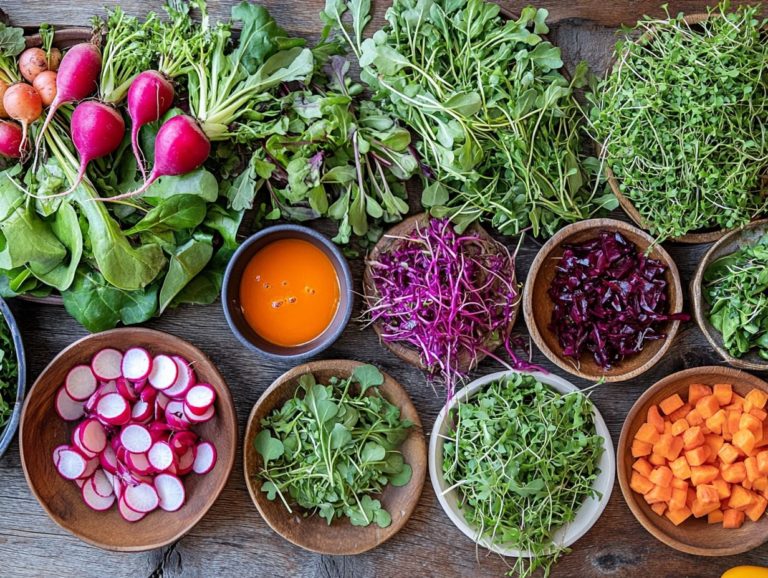77. 5 Best Microgreens for Flavorful Salads
Microgreens are tiny, nutrient-packed powerhouses that elevate salads. They’re a must-try for anyone interested in seasonal eating.
These vibrant greens enhance your meals. Here are five standout varieties that offer flavor and health benefits.
From the peppery kick of arugula to the crunchy delight of sunflower shoots, discover how to grow, store, and utilize microgreens in your salads. You’ll also learn about their nutritional advantages and any potential risks.
Revamp your salads with these quick and delightful microgreen recipes!
Contents
- Key Takeaways:
- 2. Why Are Microgreens Good for Salads?
- 3. The Top 5 Microgreens for Salads
- 4. Arugula
- 5. Radish
- 6. Sunflower Shoots
- 7. Pea Shoots
- 8. Broccoli
- 9. How to Grow Microgreens at Home
- 10. Tips for Using Microgreens in Salads
- 11. Nutritional Benefits of Microgreens
- 12. Potential Risks of Eating Microgreens
- 13. How to Store Microgreens
- What Are Other Creative Ways to Use Microgreens?
- Frequently Asked Questions
Key Takeaways:

- Adding microgreens to salads enhances the flavor and nutritional value of the dish.
- Some of the best microgreens for salads include arugula, radish, sunflower shoots, pea shoots, and broccoli.
- Microgreens should be stored properly, and precautions should be taken when consuming them to avoid potential risks.
2. Why Are Microgreens Good for Salads?
Microgreens are an exceptional choice for salads. They enhance the flavor profile while providing a wealth of health benefits and concentrated nutrients.
Microgreens like arugula, radish, and sunflower add a burst of taste that elevates a simple salad to gourmet status. Beyond flavor, they introduce vibrant colors and textures, making each bite a visual delight.
The health benefits are equally impressive: microgreens are brimming with antioxidants substances that help protect your body from damage and essential vitamins that can boost your overall wellness.
When you pair these greens with a light dressing of lemon juice and olive oil, you truly elevate their taste. The unique characteristics of each microgreen shine through, resulting in a delightful and nutritious meal.
3. The Top 5 Microgreens for Salads
When crafting delicious salads, certain microgreens like mustard and garden cress stand out, bringing both delicious appeal and a variety of flavors that make them essential ingredients.
These tiny greens are not just a feast for the eyes; they also deliver an impressive punch in taste and nutrition. Take arugula, for instance; its peppery kick beautifully contrasts with sweeter salad components, creating a delightful balance.
Then there are radish microgreens, offering that signature radish bite in a more delicate form, enhancing any dish. Sunflower shoots bring a mild nuttiness and a creamy texture that pairs perfectly with vinaigrettes.
Meanwhile, pea shoots add a fresh, sweet note that captures the essence of spring, and broccoli microgreens provide a subtle crunch along with remarkable health benefits.
By incorporating these microgreens into your salads, you infuse your meals with a burst of nutrients, transforming everyday dining into a gourmet experience.
4. Arugula
Arugula, with its peppery flavor and unique taste profile, is a standout choice, whether you’re a chef or a home cook aiming to elevate salads with vibrant microgreens that are also easy to grow.
This leafy green not only provides a delightful kick to mixed greens but also harmonizes beautifully with various ingredients think creamy avocados, sweet fruits, and tangy cheeses creating a symphony of textures and flavors in every bite.
Beyond its culinary charm, arugula is a nutritional powerhouse, rich in vitamin K to support bone health and packed with antioxidants that help combat oxidative stress.
If you’re interested in growing your own, cultivating arugula microgreens at home is easy. Simply sow the seeds in a shallow tray filled with quality potting soil, ensure they receive adequate light, and watch them flourish within weeks, bringing a fresh and zesty addition to any dish.
5. Radish
Radish microgreens bring a delightful sweet-hot mustard flavor to your cooking, making them an exciting addition to salads and a fantastic way to introduce a variety of flavors.
Their unique taste doesn t just elevate standard greens; it also adds a vibrant splash of color to any dish. With their crisp texture, these microgreens harmonize beautifully with everything from creamy dressings to zesty vinaigrettes.
Beyond their culinary charm, radish microgreens are a powerhouse of health benefits, rich in vitamin C to help boost your immune system and support overall well-being.
If you re considering home gardening, growing radish microgreens is a walk in the park. They require minimal space and flourish indoors with just a bit of sunlight, making them an accessible choice for anyone passionate about healthful eating.
6. Sunflower Shoots
Sunflower shoots are not just a feast for the eyes; they re packed with flavor and essential nutrients, adding a delightful crunch to any salad you create.
These tender greens offer about 2 grams of protein per ounce, which is impressive for a vegetable. They’re also loaded with vitamins A, B, C, and E, along with essential minerals like magnesium and iron.
Incorporating sunflower shoots into your meals is easy. Toss them into a vibrant salad, layer them in sandwiches, or blend them into smoothies for a unique texture. Their nutty flavor beautifully enhances everything from grain bowls to wraps.
7. Pea Shoots

Pea shoots are a culinary gem, celebrated for their sweet, tender leaves and versatility. Add these to your salads for a pop of flavor and freshness!
These greens offer a refreshing crunch and a sweet flavor that balances your dishes perfectly. Their delicate tendrils and bright green hue elevate both the visual and taste appeal of any salad whether it’s a simple mix with a citrus vinaigrette or a more elaborate creation featuring fruits, nuts, and cheeses.
Rich in vitamins A, C, and K, along with essential minerals, these shoots support your overall wellness. For indoor gardening, plant them in a shallow container filled with rich soil the soil or mix you plant in ensuring they have access to bright light, and you’ll enjoy a bountiful harvest in just a few weeks.
8. Broccoli
Broccoli microgreens are celebrated for their exceptional nutritional benefits, providing a concentrated source of antioxidants and essential vitamins. Vitamin K plays a pivotal role in bone health and blood clotting, making these tiny greens an amazing addition to your diet.
Incorporating them into your salads boosts nutrition while providing a delightful crunch and peppery flavor. If you re interested in growing them at home, you ll be pleased to know it requires minimal equipment. All you need is quality seeds, a shallow tray, and a suitable growing medium.
Keep them moist and ensure they receive ample light, and you can look forward to a bountiful harvest that allows you to enjoy their health benefits fresh from your kitchen garden.
9. How to Grow Microgreens at Home
Growing microgreens at home is rewarding and a quick way to add fresh flavors to your meals.
These tiny greens can enhance salads or be enjoyed as a nutritious snack. Start by selecting seeds suitable for your climate and choose a good soil mix.
Ensure they get enough light to help them grow quickly.
For instance, seeds like radishes, broccoli, and mustard thrive indoors. Keep the soil moist but avoid overwatering for a bountiful harvest.
10. Tips for Using Microgreens in Salads
Adding microgreens to salads can transform ordinary dishes into flavorful masterpieces.
These nutrient-packed greens boost flavor, texture, and color. Pair them with roasted veggies or creamy cheeses for the best results.
For a refreshing dish, try radish microgreens with sliced avocados and feta cheese.
Use light dressings, like lemon vinaigrette, to let the microgreens shine. You can also create a unique salad featuring pea shoots, sweet strawberries, and a balsamic reduction.
11. Nutritional Benefits of Microgreens
Microgreens are not just delicious; they’re also packed with nutrition.
They provide vital vitamins A, C, and K, which boost immune function, skin health, and bone strength. A small serving of microgreens can have up to six times the vitamin C of mature plants.
These greens are also high in antioxidants, which help protect your body from stress. By adding them to your meals, you enhance your diet and enjoy vibrant flavors and textures.
12. Potential Risks of Eating Microgreens
Though nutritious, there are some risks with microgreens to be aware of.
The main concerns are contamination and food safety since they are often eaten raw. Harmful bacteria like E. coli and Salmonella can grow in the moist conditions where microgreens thrive.
Wash them thoroughly under running water before eating. Choose reputable sources or grow them at home for the best quality.
Proper storage is also important. Keep microgreens refrigerated and eat them within a few days to reduce the risk of foodborne illnesses.
13. How to Store Microgreens

Properly storing microgreens is essential for retaining their vibrant flavor and nutritional quality. This ensures you can savor their benefits for a longer time.
To achieve this, maintaining optimal conditions is key. Store them in a cool environment around 34-38 F (1-3 C) in your refrigerator. Wrap your microgreens in a damp paper towel before placing them in a breathable container. This allows for essential air circulation, helping to prevent unwanted moisture buildup.
Perforated plastic containers are particularly advantageous. They effectively regulate humidity while keeping excess moisture at bay crucial for preventing spoilage. If you’re purchasing microgreens in bulk, remember that keeping them dry before storage is vital. Moisture is the enemy of freshness and can drastically shorten their shelf life.
What Are Other Creative Ways to Use Microgreens?
Beyond just salads, you can creatively incorporate microgreens into a variety of dishes. This enhances both flavor and nutrition in your cooking.
These vibrant greens have concentrated flavor profiles that can transform a simple sandwich into a gourmet experience, elevating both taste and visual appeal. When tossed into wraps, they bring a delightful crunch that harmonizes beautifully with other fillings.
Smoothies also benefit from their addition. These tiny powerhouses blend right in, making your smoothies even better! They not only supply essential vitamins but also add an intriguing layer of taste. Using microgreens as a garnish in soups or entrees brightens the dish and introduces an unexpected flavor contrast, showcasing the best microgreens for nutritional value and their remarkable versatility across various cuisines and cooking styles.
What Are the Different Types of Microgreens?
Microgreens present an impressive array of types, each boasting unique flavors, textures, and culinary charm that can elevate your dishes to new heights.
Among them, mustards catch the eye with their bold, peppery bite perfect for enlivening salads and sandwiches. Beets, with their subtle earthiness and vibrant hue, shine as garnishes for entr es or blend seamlessly into smoothies.
Peas offer a refreshing sweetness that pairs wonderfully with everything from soups to grain bowls. Each microgreen not only enhances flavor but also enriches nutritional value.
For example, mustard microgreens are abundant in vitamins A, C, and K. Beet microgreens brim with antioxidants, and pea shoots are an excellent source of protein. Grasping these nuances can genuinely amplify your culinary creativity.
How Do Microgreens Compare to Full-Grown Greens in Terms of Nutritional Value?
Microgreens outshine their fully grown counterparts, boasting a higher nutritional value and concentrated nutrient content. This makes them a critical part of a healthy diet.
These tiny greens, harvested just after their first leaves emerge, deliver a potent punch of vitamins and antioxidants that far exceed those found in mature varieties. Take mature spinach, for example; while it’s famous for its iron content, some microgreens can provide significantly more, packing nutrients into a compact form.
The vibrant colors and diverse varieties not only enhance the visual appeal of your meals but also elevate your intake of flavonoids (natural compounds that may help reduce inflammation) and carotenoids, essential for combating oxidative stress. By seamlessly integrating microgreens into your daily meals, you can effortlessly elevate your nutrient intake and enjoy the benefits of these nutritional powerhouses.
What Are Some Delicious Salad Recipes Using Microgreens?
Creating delicious salad recipes with microgreens can be a delightful way for you to explore their culinary potential while enhancing your healthy eating habits.
These tiny, flavorful greens have the remarkable ability to transform a simple salad into a gourmet experience, delivering a rich array of nutrients that support your overall wellness. From the peppery zing of arugula sprouts to the delicate charm of beet greens, the variety available ensures there’s something to satisfy every palate. To elevate your dishes further, explore the ways to enhance flavor in microgreens.
Get ready to impress your taste buds with exciting new salad recipes using microgreens! You’ll find recipes that are easy to make and packed with flavor, complete with detailed ingredient lists and straightforward preparation methods. Each salad will showcase its specific health benefits, encouraging you to cultivate a deeper appreciation for these nutritious powerhouses in your everyday meals. To start, consider choosing the right microgreen seeds for your salads!
Are There Any Precautions to Take When Eating Microgreens?
While microgreens are a delightful addition to a health-conscious diet, it’s wise to take certain precautions to ensure safe consumption.
To begin, if you’re planning to grow or purchase these young greens, make it a priority to wash them thoroughly. This simple step helps eliminate any lingering soil or pathogens.
Proper storage is crucial. Keep your microgreens in a cool, dry place or refrigerate them to maintain freshness and minimize the risk of spoilage.
Sourcing healthy vegetable seeds from reputable suppliers is paramount as well. This choice lays the groundwork for cultivating high-quality microgreens.
By following these food safety practices, you can savor the vibrant flavors and health benefits of microgreens with greater peace of mind, effectively reducing any potential health risks.
How Can Microgreens Be Used in Other Dishes Besides Salads?

Beyond salads, there s a world of culinary possibilities waiting for you with microgreens. Transform your meals with a burst of flavor and nutrition! These tiny greens can enhance the flavor of your dishes and provide extra nutrition to your everyday meals.
Take soups, for example; adding microgreens can elevate the flavor, introducing a fresh, peppery note that complements both creamy and broth-based creations beautifully.
For breakfast, toss them into your omelets for added color and nutrition. Layering microgreens into your sandwiches offers a delightful crunch, making each bite more satisfying.
Their versatility shines in wraps and grain bowls as well, proving that these power-packed plants are not just a garnish they are a vital component of innovative and health-conscious cooking.
Frequently Asked Questions
What are microgreens?
Microgreens are young edible plants of various vegetables and herbs that have been harvested at an early stage, usually within 1-3 weeks of germination. They are packed with flavor and nutrients, making them a popular addition to salads and other dishes.
What makes microgreens great for salads?
Microgreens add a burst of fresh flavor to salads, making them more interesting and nutritious. They are also easy to grow at home, making them a convenient and affordable option for incorporating into your meals.
What are the 5 best flavorful microgreens for flavorful salads?
The 5 best microgreens for flavorful salads are broccoli, kale, radish, sunflower, and pea shoots. These versatile plants offer a range of diverse flavors, from spicy to nutty, and can be easily grown at home.
What are the benefits of broccoli microgreens in salads?
Broccoli microgreens have a mild, slightly sweet flavor and are packed with nutrients like vitamins A, vitamin C, and vitamin K. They also contain sulforaphane a compound in broccoli that may help fight inflammation and cancer.
How do you grow baby plants at home?
To grow microgreens at home, you will need a shallow container, potting soil, and the vegetable seeds of your chosen microgreens. Simply spread the seeds evenly over the soil, lightly cover with more soil, and water regularly until they are ready to be harvested.
Can microgreens be used in seasonal eating dishes other than salads?
Yes, microgreens can be used in a variety of dishes, including sandwiches, wraps, omelets, and soups. They can also be added as a garnish to give a pop of flavor-packed flavor and color to any dish.






